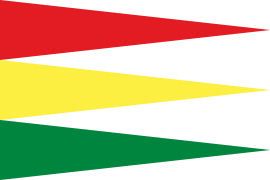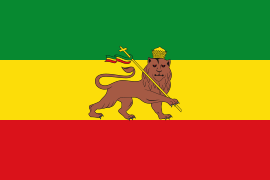Ethiopian flag
The current version of the Ethiopian flag was adopted on October 31, 1996. It consists of three horizontal stripes of equal size: the upper one is green, the central one yellow, and the lower one red. In the central part, occupying the central strip and part of the outer ones, is the coat of arms of Ethiopia, formed by a blue circle with a golden five-pointed star (like a pentalpha).
The meaning of the colors of the flag has varied over time. Currently, the green color represents the fertility of the country, the yellow symbolizes religious freedom and the red color evokes those who died defending national integrity.
The golden five-pointed star on the shield represents equality between men and women, of all ethnic and religious groups. The rays between the points of the star reflect the free, fair and bright future of Ethiopia. The blue color of the emblem symbolizes the peace and democracy desired for the country.
The pan-African colors - red, green, yellow - are based on the Ethiopian flag, one of the oldest on the African continent. The tricolor scheme of the flag is very old, predating the creation of the banner of the Abyssinian Empire. The three colors also made up the flag created in 1897, a year after the Battle of Adowa, in which the Ethiopians defended themselves against Italian colonial expansionism.
During the existence of the Ethiopian monarchy, a crowned lion was represented on the flag, known as the “Lion of Judah”, which carried a banner with a cross incorporated into the end of the mast, a symbol of country's link with the Ethiopian Orthodox Church.
With the disappearance of the Ethiopian monarchy in 1975, the national flag had the same elements, but the Lion of Judah was removed and no new shield or emblem was incorporated. This flag was used until 1987 and then from 1991 to 1996.
Between 1987 and 1991, in the center of the flag was the coat of arms of the People's Democratic Republic of Ethiopia, dominated by a five-pointed yellow star located at the top and surrounded by a crown or garland of plants.
Historical flags
Contenido relacionado
Pachamanca
Shield of Brazil
Ukrainian flag






